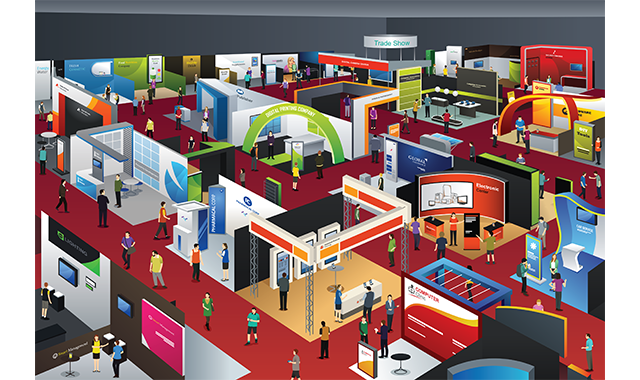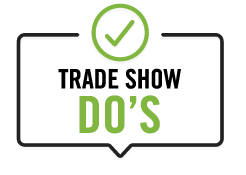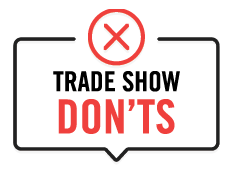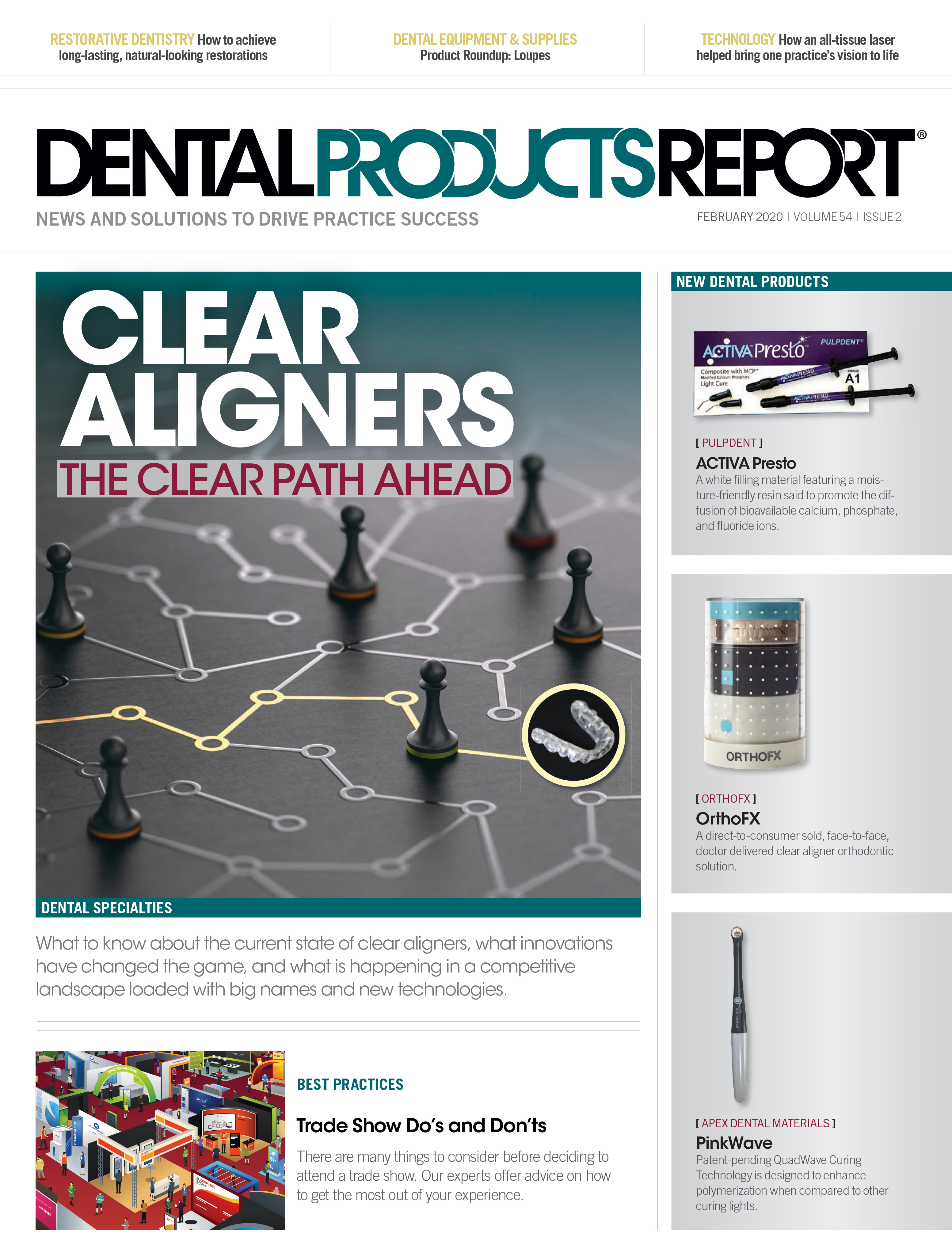Show Do's and Don'ts: A guide to navigating the trade show floor
There are many things to consider before deciding to attend a trade show. Our experts offer advice on how to get the most out of the experience.

You did it. You registered and invested to attend a trade show for the benefit of your career, practice, and patients. Well done, you. But, what now?
As it turns out, a lot of things. Preparing for a trade show can help you make the most of your investment. We spoke to experts about what you should be doing in the time leading up to your show and during it, as well as common mistakes to avoid.

Determine your goals for attending
Clinicians should remember why they chose to attend the show and then, focus on attaining those goals, according to Jason Goodchild, DMD, Vice President of Clinical Affairs for Premier Dental Products Company.
“Ask yourself, ‘Why do I go to these shows?’” Dr. Goodchild says.
Clinicians should ask themselves this question because the need to travel to shows is not the same in 2020 as it was in 1999, Dr. Goodchild says. In the past, attendees needed to go to the shows to buy a lot of stuff and get a lot of continuing education (CE) credits. Now, it’s possible to do that without attending a trade show.
To get the most out of the show, it’s important to identify why you wanted to go in the first place. The social networking that occurs at tradeshows is one way of doing business that is hard to replicate in other arenas. There are tremendous social networking opportunities at a show, Dr. Goodchild says.
“There are fantastic opportunities to bring large groups of people together,” he says. “And the booths and the exhibit hall, they’re just awesome.”
Some dentists like to use products that “feel good in their hands.” However, this mindset can lead to getting stuck in a rut and missing out on new material and equipment improvements. Seeing how other people do things and the latest products that you haven’t tried before can help dentists expand their horizons. A trade show shines in this area, Dr. Goodchild says. Moreover, the samples you collect there allow you to find out what else feels good in your hands.
“There are so many opportunities to try new things and have your eyes opened about what else is out there, that maybe the shows can help us break out of that mold a little bit,” Dr. Goodchild says.
Plan to divide your time
Kim Miller, RDH, BSDH, finds balancing the different types of programs, such as education, exhibit hall time, and social events a challenge. There is always so much to do and see and so many courses she would like to attend, she says. Miller’s overall strategy is to divide her time between sessions and the exhibit hall. She takes morning or early afternoon classes and then hits the exhibit floor in the afternoon.
“Plan ahead; otherwise, you wander around and waste time,” Steve Jones, Co-Chair of Roots Summit, a global endodontic meeting, agrees. “Decide what you want to accomplish before you get there so you can make the most of your time while you are there.”
Janis Moriarty, DMD, is President of the Massachusetts Dental Society and past General Chair of Yankee Dental Congress held annually in Boston at the end of January. Dr. Moriarty recommends people go through the program book as soon as it is available, either in print or online.
“It’s much more of an exciting and fulfilling experience if you have a plan of attack before you get there,” Dr. Moriarty says. “For someone that’s never been before, the size of the building and the number of courses and events available can be intimidating. Doing a little homework ahead of time will help once you get onsite.”
Miller agrees one of the most important things to do before the trade show is to review the catalog. She looks for intriguing course topics and ads for new equipment or services she is interested in, which she earmarks so she can visit that booth.
“My advice is to be selective with the courses you choose and, as I mentioned, divide your time between courses and exhibit hall. Go to a two or three-hour course, then hit the exhibit floor for a couple of hours or vice versa,” Miller says.
Look for CE opportunities and educational programs
One of the most significant committees for the meeting is Programming, which begins planning the CE component two years before the meeting, says Dr. Moriarty, who is a private-practice dentist in Winchester, Mass., just outside of Boston and has worked at Yankee Dental in various roles as a volunteer for more than 20 years.
“There are many reasons to attend the meeting, but a necessity for sound practice is to get CE. We have a vast number of courses, and we look at trying to balance all the different specialties and general dentistry, as well as courses specific for auxiliaries,” Dr. Moriarty says.
Another approach is to review what educational opportunities you haven’t taken recently, says Tina Clarke, RDH and instructor at Lane Community College in Eugene, Ore. She also suggests researching new ideas emerging within the profession, such as diagnostics or techniques.
“The other thing, too, is the basic items that you have to have for state licensure within Oregon. If I can get those while I’m there, that makes it nice,” Clarke says.
Continue reading on the next page...
Sign up early
Miller recommends signing up early for the courses that are of the most considerable interest. Seats typically go fast for sessions in high demand, plus, she adds, you won’t pay late registration fees for the courses. Miller also advises dental professionals to make their hotel reservations early, as soon as the blocks open.
“Hotels fill up fast, and you can always cancel your reservation, within limits, if your plans change,” Miller says. “To avoid disappointment, early sign up is the best.”
“I look online and pick all the classes I want to go to and the big-name speakers or the topics I’m interested in learning. That’s going to be my background,” Dr. Goodchild says regarding the sign-ups. “I am going to get the CE I want to get."
Map Out Your Exhibit Floor Time Beforehand
Identifying any upcoming needs is always a good idea, Clarke says. If there are any big-ticket items that are needed, research them before the show.
“For example, if I need to update my intraoral camera, I start looking to see what different features the companies have on their cameras. Then, I can develop questions for when I go to their booth for a demo,” Clarke says.
Dr. Goodchild follows a similar approach, considering capital purchases he has coming up for the practice. He says for the significant technology purchases, such as digital scanners, trade shows offer a rare opportunity to comparison shop in-person.
“It does allow you to see all of them at one time, put your hands on them, and find out which one feels the best,” Dr. Goodchild says. “And then when you zero in on it, you can contact the company, and the manufacturer can bring it to your office so you can give it a try.”
Attendees should have an inventory of what they want to look at ahead of time, Clarke suggests. The trade show organizers often publish a map of the exhibitor floor and where the anchor booths will be. Having an idea of what the company’s booth number is can be helpful, especially if you don’t have a ton of time on the floor at the show, she adds.
Miller locates the booths she wants to visit on the map and makes a note of the booth number. She then works her way through the exhibit hall systematically, starting with lower booth numbers and moving up.
“This way, when I make an unplanned stop, I don’t lose sight of my goals, and I can get right back to the planned stops,” Miller says.
Dr. Moriarty notes that the Yankee Dental Congress has an exhibit guide at the back of the program book. Also, a custom app is available two weeks before the meeting that has the “meeting at your fingertips.”
“You can certainly take a peek at companies you might want to see. Also, you can take advantage of some of our marketing programs where you spend a certain amount of money and get a certain amount back and other incentives to do some shopping,” Dr. Moriarty explains.
“I don’t think you should want to walk around the exhibit floor blindly,” Dr. Goodchild says. “If I’m interested in seeing some things, I’d like to know that they’re there and then make a bit of a plan.”

As the seasoned attendee could probably tell you, there are definitely things to avoid while perusing a trade show. Our experts added their own advice on common mistakes and how to avoid them.
Not Having a Plan for the Exhibit Floor and Booth Time
Just as having a plan is a definite ‘do’, not having a plan is a certain ‘don’t’.
Trade shows are the place to see the equipment in-person that you are interested in or want to know more about, Jones says. Find out where those are and make sure that you target those booths during those times.
“Too many doctors come without a plan, end up wandering around and buying something that they stick in the accessory drawer and never pick up again,” he says.
When visiting exhibitors, it’s good to have specific questions to ask people and to take advantage of your time with them, Jones says. Don’t assume there’s nothing to be learned from someone who isn’t a dentist; there are a lot of experts who have a lot to offer in the booth, he adds.
At busy booths, Clarke says to be sure to have questions ahead of time because the exhibitors are trying to serve as many people as possible. You want to get the information you need while respecting the exhibitors’ and other patrons’ time.
“If you are prepared to pay at that moment as well, that will expedite everything, too. You can leave the show, and the vendor can ship what you want off to your office,” Clarke says.
Dr. Goodchild admits that there is some fun to strolling around and window shopping. However, if something is needed for the office, you need to know what is available for you to see in-person to determine which ones you want to consider.
“And then potentially making an appointment for a rep to come to my office to try it out,” Dr. Goodchild says. “Or, if they do have a crazy show special, is there a way to ‘buy it and try it’?”
Continue reading on the next page...
Wardrobe Malfunctions, Going Hungry, Getting Cold
Almost anyone can tell you trade shows involve lots of walking, so choosing the right shoe is imperative. Clarke admits she has made a mistake choosing something cute over something practical, and her feet paid the price for it.
“Sometimes we want to get super dressed up, and we have on our high heels. Then, you’re trying to scooch and hurry, and that may not necessarily be great for your feet if you’re on them for a long time,” Clarke says. “I’ve made those mistakes before. By the end, I was like, ‘Oh, I can’t look at any more stuff!’”
Miller agrees that comfortable shoes are essential. She also says to bring a sweater or jacket, even if you are in a warm climate.
“Dress in layers. The rooms are always cold,” she advises.
Another important consideration is whether there is food offered on the show floor. Clarke says if there is, sometimes you can pull double duty and eat lunch while you look at things. Also, take advantage of sponsored lunch events, too.
“If you know that you aren’t going to have that [lunch], make sure you have snacks in your bag that you can munch on,” Clarke says. “It’s important because it’s hard to make purchasing decisions when your feet hurt and you’re hungry.”
Dr. Goodchild attended the Star of the North in Minneapolis in 2019 and appreciated a tactic they had for combining socializing and shopping on the exhibitor floor at the end of the day when everyone was ready to go home. They gave attendees a reason to stick around for a while, do some networking, and walk the exhibit floor, he says.
“They did a happy hour from 5 p.m. to 6 p.m. with free beer and wine,” Dr. Goodchild said. “The exhibition floor was packed.”
Going It Alone
As important as it is to search out and try new products, trade shows are about networking with other professionals as much as anything else. It’s a good idea to use the buddy system, meaning meet up with a buddy or travel with one, Miller says.
“These events are always more fun in pairs or groups,” she says. “Split up, go your own way, and then meet back up later to share what you learned, who you talked to, etc. Sometimes the exchange between colleagues is the best part of the event.”
When Clarke goes to shows that are in different areas, she also arranges to meet with friends and walk the floor with them. This is a great time to network and talk with colleagues she doesn’t see often, she says. She also arranges to meet them at the social events or dinners sponsored by the show.
“That’s some of the fun,” Clarke says. “Getting to experience those professional perks with your colleagues makes it possible to develop those friendships.”
Skipping the Social Events
Skipping the social events at a trade show is a mistake, according to Jones. The social aspect of a trade show is an area that many attendees appreciate the most. He highly recommends going to social events because meeting other doctors and specialists broadens your network and your knowledge base.
“Social events are some of the most important parts of a trade show. You meet other doctors and exchange ideas in ways you wouldn’t get through any other forum,” Jones says.
Social events are a vital part of the meeting, Dr. Moriarty agrees. She recommends using social media to determine if your friends and colleagues are going.
“Nowadays, with all of those outlets, it’s really easy to both encourage people to go and be encouraged to go,” Dr. Moriarty says.
Not Balancing Your Day
Clarke, who is launching a new online platform called “Teacher Tina, RDH,” says education is vital to her. However, too much of a good thing can be a bad thing. Clarke follows a basic plan to do courses in the morning, the trade show floor at lunch, and then have the afternoon and evening for social events or sight-seeing.
“The research I’ve done suggests that there’s not a lot of retention that happens after several hours of sitting and learning, you’ve already been getting a lot of brain work accomplished. For me, I’ll do my learning in the morning and have my fun in the afternoon,” Clarke explains.
Breaking up the day with walks through the exhibits can help, Miller suggests. “I don’t want to sit all day, so, at a minimum after each course, I hit the exhibit hall floor for an hour or two between courses whenever possible,” she says of her schedule balancing strategy.
One of the things organizers of Roots Summit want to provide attendees are clinical tips they can use in the operatory, Jones explains. However, they also build in lunch and breaks, with time to get to the floor and explore, as well. The idea is to balance between clinical learning and technology exploration.
“The keynotes and breakouts are for clinical education. The exhibit floor is to talk to vendors and see the equipment that you want to see. However, you could get great advice from the reps on the floor, so don’t count that out,” Jones says.
Only Hitting “Big-Name” Shows
Attending smaller regional trade shows periodically can offer some variety from the bigger shows, Clarke says.
“The product reps might have something a little bit different to offer, and some of the courses might be different, too,” Clarke explains.
259 Prospect Plains Rd, Bldg H,
Cranbury, NJ 08512
All rights reserved.
